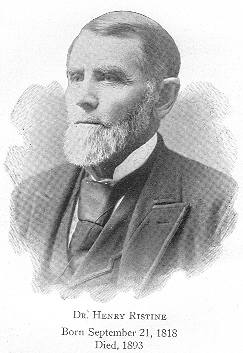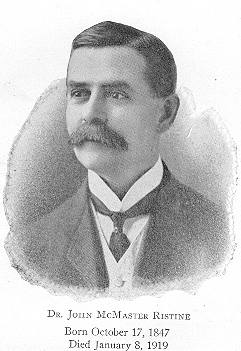| Mark Raney pg 273-274, full text Dr. Mark Raney was born in Westminister, Vermont, July 7, 1827, and died at the Insane Hospital at Mt. Pleasant February 1, 1882 of pneumonia. Dr. Raney had received the advantages of a college training, studied medicine with Dr. Campbell of Westminister and in 1849 graduated from the Vermont Medical College. Soon after graduation Dr. Raney was appointed assistant physician to the Butler Hospital, Providence, R.I., under the superintendency of the distinguished alienist Dr. Ray. After five years service, in 1854 was appointed to a more desirable position in the McLean Hospital near Boston, under Dr. Luther V. Bell. On the resignation of Dr. Patterson as superintendent of the Mt. Pleasant Hospital in 1864, Dr. Raney was appointed to fill the place. Dr. Raney's scholarly attainments and thorough
training under the hands of masters in hospital work well
fitted him for a field of great usefulness in directing
the Iowa institution. In 1871 he was appointed lecturer
on insanity at the medical deparment of the Iowa
University at Iowa City, which position he held at the
time of is death. It was the exposure incident to going
to Iowa City to lecture, on his way to attend a meeting
of the Iowa State Medical Society at Des Moines, that he
contracted pneumonia. |
| E.D. Ransom pg 105, mention Dr. E.D. Ransom, of Burlington, was a charter member of the Iowa State Medical Society, in 1850. |
| S.S. Ransome pg 18 & 25, mention Dr. S.S. Ransome came to Burlington in 1835 where he remained until his death in 1872. |
| J.H. Rauch pg 105, mention Dr. J.H. Rauch, of Burlington, was a charter member of the Iowa State Medical Society, in 1850. |
| Charles Hamilton Rawson pg 202, mention; and 253-254, full text Dr. Rawson was practicing medicine in Des Moines in the mid-1860's (pg 202) Charles Hamilton Rawson Dr. Rawson began the study of medicine with Dr. A.P. Barber, a local physician of considerable note and graduated from the Woodstock Medical college, Vermont. After practicing medicine in Canada for two years, he attended a course of medical lectures at the College of Physicians and Surgeons, New York City, where he received an additional degree of M.D. After graduating, Dr. Rawson served an internship in one of the New York hospitals. In 1849 during the California gold fever, he secured the position of ship's surgeon on S.S. Lewis plying between New York and San Juan and San Francisco via Cape Horn. He served on this ship until it was wrecked near Acapulco. After the loss of his ship, he served as surgeon in the Marine Hospital at San Francisco for a period of two years. He then returned to Vermont and in 1856 located in Des Moines. In 1861, Dr. Rawson was made surgeon of the Fifth Iowa Infantry and later was appointed brigade surgeon and served until impaired health compelled him to resign. He them resumed practice in Des Moines. In November, 1865, Dr. Rawson married Miss Mary E. Blake of Swanton, Vermont. In 1868 he became a member of the Iowa State Medical Society and later of the American Medical Association. Dr. Rawson was a quiet and reserved man of sound judgment, conservative in business and in professional relations, and successful in both. (pg 253-254) |
| George Reeder pg 105, mention Dr. George Reeder, of Muscatine, was a charter member of the Iowa State Medical Society, in 1850. |
| S.E. Reinhart pg 38, full text Dr. S.E. Reinhart a graduate from Jefferson Medical College came to Oskaloosa in 1846. When the Mahaska County Medical Society was organized in 1856, Dr. Reinhart was elected its first president. It does not appear that he at any time occupied public office, although well fitted by ability and education, but preferred to remain a devoted practitioner of his profession. He was a cultivated gentleman, enjoying the confidence of the public and the affection of the medical profession of his county. He died of pulmonary tuberculosis in 1875. |
| Albert Reynolds pg 275-276, full text
Dr. Albert Reynolds He located in Clinton, Iowa in 1867 and there married Miss Sarah Rogers, a teacher and a member of a prominent family of the State of New York. In 1873 he became superintendent of and opened the state hospital for the Insane at Independence. After a faithful and successful service, he retired from office in 1881 on account of failing health and resumed private practice in Clinton. He continued in the active practice of his profession until a few weeks before his death. He lectured upon insanity in the medical department of the State University of Iowa for several years. Dr. Reynolds was well prepared and qualified to stand at the head of this new and excellent institution. He was good sized, good looking, and a good example for his associates. Even more, he was naturally and always a gentleman. He had self-respect and was patiently respectful to everybody. He was the personification of good common sense. He was always busy in his office, in the wards, and, on occasion, on the streets engaged in various affairs. He chose to spend his evenings in the study of scientific subjects or taking turns with his wife in reading aloud books of art, biography, fiction or history. Dr. Reynolds was devoted to his two sons; one of whom became a lawyer and the younger, a physician who is now a psychiatrist in charge of a government hospital in Boston, Massachusetts. The subject of this sketch was never active in politics. Men in the hospital and in the City of Independence hardly knew that Dr. Reynolds generally in county, state and national affairs voted the democratic ticket. Early in life he chose to attend the Episcopal church, but after marriage he enjoyed attending and supporting the Presbyterian church in company with his admirable wife. |
| Ephraim M. Reynolds (Dr. Reynolds *) pg 283 & 321, mention The first State Board of Health was organized in 1880 and held its first meeting on May 18, 1886 and was composed of seven physicians, including Dr. Reynolds from Centerville. (pg 283) A member of the first State Board of Health, 1880, from Waterloo. (pg 321) [transcribers note: I believe both instances refer to the same man, but the researcher should make the determination for themself & also his correct residence] |
| George W. Richards pg 150, mention The Northwestern Medical Society was organized in Iowa on November 4, 1852. Dr. George W. Richards was elected president. |
| Professor Richards pg 67, mention A professor of 'practice' at the "Medical College of the Upper Mississippi" in Davenport, 1849. [transcriber note: he may not have been a physician] |
| S.E. Rienhart pg 155, mention The first medical society in Mahaska county was organized in 1856. Dr. S.E. Rienhart, president. |
| Henry Ristine pg 33-34, full text
Dr. Henry Ristine, brother-in-law to Dr. Holmes [Magnus Holmes] came to Marion in 1842 and practiced medicine in Marion and Cedar Rapids, fifty-one years; truly a long life of service in practically the same communtiy. Dr. Ristine sustained the closest relations to the family life of his people and as the trusted physician had opportunities to observe the elements that make up the strength and the weakness of a community. Dr. Ristine did not seek public office, notwithstanding the temptations which must have come to him at times when opportunities for an interesting medical practice were few. His activities were wholly welfare, social and professional in character. The opportunities such as they were, gave Dr. Ristine a reputation as a surgeon which led to his appointment as chief surgeon for the Burlington, Cedar Rapids and Northern Railway and district surgeon for the Chicago and Northwestern Railway. Dr. Ristine early recognized the need of a hospital in a growing community which had for so many years depended on home treatment for serious medical and surgical cases, and for the care of injured industrial workers, with whom he had much to do. Hospitals at that time were in no great favor with the public generally, and strange as it may seem to us now, such welfare institutions were extremely difficult to organize, but with the assistance of his friend, Judge Green, St. Lukes' had a beginning and Dr. Ristine was made a member of the first consulting staff. In medical societies he was a leading influence. The Linn County Medical Society was organized in 1859 and Dr. Ristine was one of the five original members. In 1873 he became a member of the Iowa State Medical Society and in 1877 was elected its president. Dr. Henry Ristine was born September 21, 1818, near Albany, Ky. Moved with his parents into southern Indiana when two years of age. Attended Wabash College at Crawfordsville, Indiana, but did not finish the course. Graduated at the Ohio Medical College in 1851 after having practiced medicine in Marion, Iowa, for several years; having located at the latter place in winter of 1842. Was married to Miss Katherine McMaster in Crawfordsville, Indiana, in 1844, and died at his home in Cedar Rapids in 1893. |
| John M. Ristine pg 34-35, full text
Dr. John McMaster Ristine died at his home in Cedar Rapids of angina pectoris, January 8, 1919. Dr. Ristine was born in Marion, Linn county, Iowa, October 17, 1847. He received his literary training at Wabash College, Crawfordsville, Indiana, which institution conferred the A.M. Degree in 1908. Dr. Ristine received his medical degree from Bellevue Hosipital Medical College, New York in 1876. Immediately after graduating in medicine he began practice with his father, Dr. Henry Ristine who began practice in Marion in 1842. Both father and son represented the highest ideals in medicine and surgery and for seventy-seven years the Ristines were recognized as among the leading physicians and surgeons of Iowa. Soon after the location of Cedar Rapids the Ristines removed from Marion to the latter city and became identified with the building of the town and its industries, and were medical advisors to many of them. Surgeons for the Burlington, Cedar Rapids and Northern Railway. Afterwards the C.R.I&P.; the C.&N.W.Ry.; the Illinois Central; Street Railway; Sinclair Packing House; the Quaker Oats, etc. Dr. Henry Ristine died in 1893 and the Ristine firm was continued under the name of Ristine and Ruml. During the long period of seventy-seven years the Ristines and Ruml enjoyed a large practice among the most influential people of Cedar Rapids and their name became a household word. Dr. John Ristine continued practice up to the last day of his life. Under a mistaken idea that doctors should be rich in money and lands, Dr. John allowed the last years of his life to be clouded with the anxieties of business speculations. A great shock came to Dr. Ristine only a few weeks before his death in the death of his son Lieut. Richard Ristine in an aviation accident at Gerstner field. Dr. Ristine is survived by Mrs. Ristine and one son who is serving the United States Army in France. |


